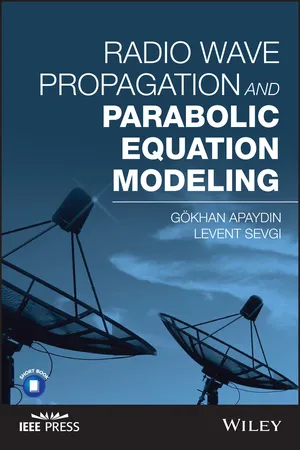
- English
- ePUB (mobile friendly)
- Available on iOS & Android
Radio Wave Propagation and Parabolic Equation Modeling
About this book
An important contribution to the literature that introduces powerful new methods for modeling and simulating radio wave propagation
A thorough understanding of electromagnetic wave propagation is fundamental to the development of sophisticated communication and detection technologies. The powerful numerical methods described in this book represent a major step forward in our ability to accurately model electromagnetic wave propagation in order to establish and maintain reliable communication links, to detect targets in radar systems, and to maintain robust mobile phone and broadcasting networks.
The first new book on guided wave propagation modeling and simulation to appear in nearly two decades, Radio Wave Propagation and Parabolic Equation Modeling addresses the fundamentals of electromagnetic wave propagation generally, with a specific focus on radio wave propagation through various media. The authors explore an array of new applications, and detail various virtual electromagnetic tools for solving several frequent electromagnetic propagation problems. All of the methods described are presented within the context of real-world scenarios typifying the differing effects of various environments on radio-wave propagation. This valuable text:
- Addresses groundwave and surface wave propagation
- Explains radar applications in terms of parabolic equation modeling and simulation approaches
- Introduces several simple and sophisticated MATLAB scripts
- Teaches applications that work with a wide range of electromagnetic, acoustic and optical wave propagation modeling
- Presents the material in a quick-reference format ideal for busy researchers and engineers
Radio Wave Propagation and Parabolic Equation Modeling is a critical resource forelectrical, electronics, communication, and computer engineers working on industrial and military applications that rely on the directed propagation of radio waves. It is also a useful reference for advanced engineering students and academic researchers.
Frequently asked questions
- Essential is ideal for learners and professionals who enjoy exploring a wide range of subjects. Access the Essential Library with 800,000+ trusted titles and best-sellers across business, personal growth, and the humanities. Includes unlimited reading time and Standard Read Aloud voice.
- Complete: Perfect for advanced learners and researchers needing full, unrestricted access. Unlock 1.4M+ books across hundreds of subjects, including academic and specialized titles. The Complete Plan also includes advanced features like Premium Read Aloud and Research Assistant.
Please note we cannot support devices running on iOS 13 and Android 7 or earlier. Learn more about using the app.
Information
CHAPTER 1
INTRODUCTION
1.1 Electromagnetic Problems and Classification









Table of contents
- COVER
- IEEE EDITORIAL BOARD
- TITLE PAGE
- Copyright
- PREFACE
- ACRONYMS
- MATLAB CODES
- CHAPTER 1: INTRODUCTION
- CHAPTER 2: WAVE PROPAGATION OVER FLAT EARTH
- CHAPTER 3: PARABOLIC EQUATION MODELING
- CHAPTER 4: WAVE PROPAGATION AT SHORT RANGES
- CHAPTER 5: PE AND TERRAIN MODELING
- CHAPTER 6: ANALYTICAL EXACT AND APPROXIMATE MODELS
- CHAPTER 7: WAVE PROPAGATION INSIDE THREE-DIMENSIONAL RECTANGULAR WAVEGUIDE
- CHAPTER 8: TWO-WAY PE MODELS
- CHAPTER 9: PETOOL VIRTUAL PROPAGATION PACKAGE
- CHAPTER 10: FEMIX VIRTUAL PROPAGATION PACKAGE
- REFERENCES
- INDEX
- EULA